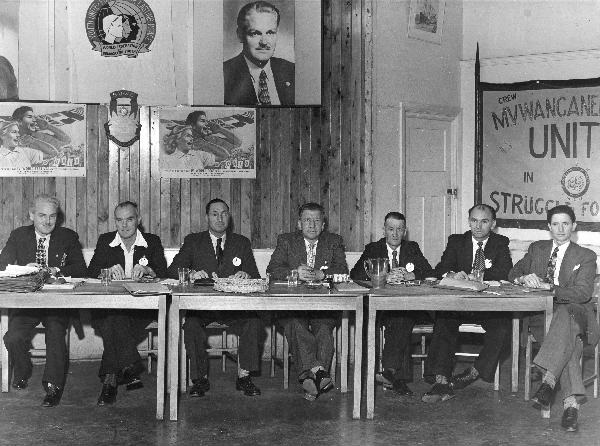Seamen's Union Of Australia on:
[Wikipedia]
[Google]
[Amazon]
The Seamen's Union of Australia (SUA) was the principal
 Following
Following
trade union
A trade union (British English) or labor union (American English), often simply referred to as a union, is an organization of workers whose purpose is to maintain or improve the conditions of their employment, such as attaining better wages ...
for merchant seamen in Australia
Australia, officially the Commonwealth of Australia, is a country comprising mainland Australia, the mainland of the Australia (continent), Australian continent, the island of Tasmania and list of islands of Australia, numerous smaller isl ...
from 1876 to 1991. The SUA developed a reputation as one of the most militant trade unions in Australia and was closely associated with the communist movement in Australia. The SUA merged in 1993 with the Waterside Workers' Federation to become the Maritime Union of Australia (MUA).
History
Background
Australian seamen were forerunners of maritime trade unionism. Efforts to form trade unions amongst merchant seamen trading out of Australian ports can be traced back to 1874, with the formation of the Sydney Seamen's Union and Melbourne Seamen's Union. The trade unions of this period inspired, among others, J. Havelock Wilson of the British National Union of Seamen, who served on Australian coasting vessels for a period in the late 1870s. By 1890, a number of these unions had come together to form a loose federation called the Federated Seamen's Union of Australasia, which includedNew Zealand
New Zealand () is an island country in the southwestern Pacific Ocean. It consists of two main landmasses—the North Island () and the South Island ()—and List of islands of New Zealand, over 600 smaller islands. It is the List of isla ...
until the Federation of Australia in 1901 which did include New Zealand, and adopted the name Seamen's Union of Australia (SUA) in 1906. For nearly eighty years the SUA successfully improved the wages and conditions of its members by negotiations with employers and governments or by taking militant industrial action.
Campaigning
 Following
Following World War I
World War I or the First World War (28 July 1914 – 11 November 1918), also known as the Great War, was a World war, global conflict between two coalitions: the Allies of World War I, Allies (or Entente) and the Central Powers. Fighting to ...
the SUA gained a reputation as a militant union, under the leadership of socialist-inclined Tom Walsh. During the Second World War
World War II or the Second World War (1 September 1939 – 2 September 1945) was a World war, global conflict between two coalitions: the Allies of World War II, Allies and the Axis powers. World War II by country, Nearly all of the wo ...
, it was instrumental in ensuring the supply of civilian seafarers for the war effort.
The SUA also took part in a wide range of social and political issues over the years, for example campaigning for Aboriginal rights, opposing apartheid in South Africa, opposing the Vietnam War, and participating in the nuclear disarmament movement.Huntley, Pat. (1985). "''Inside Australia's Top 100 Trade Unions''". Northbridge:Ian Huntley Pty. Ltd. The SUA also took part in the black bans and boycotts of Dutch shipping, where the union movement of Australia worked to aid the nascent Indonesian Republic, in particular, ensuring that no tugs towed Dutch ships. These bans commenced in September 1945, and continued through to 1949. The union's longest serving leader was Eliot V. Elliott who led the SUA from 1941–1978.
During the 1970s and 80s the union was strongly active in campaigns to address the decline of the Australian shipping industry, as alternative transport modes became more prevalent, and shipowners used flag of convenience
Flag of convenience (FOC) refers to a business practice whereby a ship's owners Ship registration, register a Merchant vessel, merchant ship in a ship register of a country other than that of the ship's owners, and the ship flies the civil ens ...
ships to reduce costs. Reduced manning levels aboard ships also negatively impacted union members, and the union negotiated with companies to maintain the job security of Australian maritime workers.
Amalgamation
During its long history the SUA underwent several amalgamations to increase its coverage of maritime workers, particularly as the size of the workforce decreased due to automation and the use of flag of convenience vessels. The Marine Cooks Bakers and Butchers Association (formed in 1908) amalgamated with the Seamen's Union of Australia in 1983, and the Federated Marine Stewards and Pantrymen's Association merged in 1988. In 1991 the Professional Divers' Association also amalgamated with the SUA, before it joined with the Waterside Workers' Federation to become the Maritime Union of Australia (MUA) in 1993.Federal Secretaries
* Arthur Cooper 1906–1918 * Tom Walsh 1918–1922 * William Raeburn 1922–1926 * Jacob Johnson 1926–1937 (imprisoned for 4 months for inciting a 1922 strike) * W. J. Daley 1937–1941 * Eliot V. Elliott 1941–1978 * Patrick Geraghty 1978–1991Further reading
* Cahill, Rowan, ''Sea Change: An Essay In Maritime Labour History'', Bowral, 1988. *Fitzpatrick, Brian and Rowan J. Cahill, ''The Seamen's Union of Australia 1872–1972: A History,'', Sydney: Seamen's Union of Australia, 1981. . *Kirkpatrick, Diane, ''Voices From the Ships: Australia's Seafarers and their Union'', Sydney: UNSW Press, 2008. .References
{{Authority control Defunct trade unions of Australia Seafarers' trade unions Trade unions established in 1890 Trade unions disestablished in 1993 Maritime history of Australia